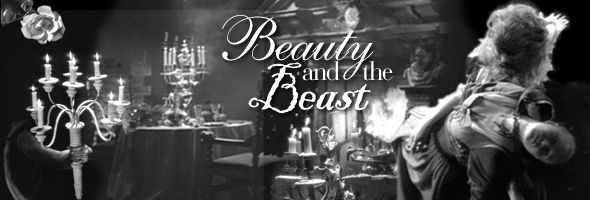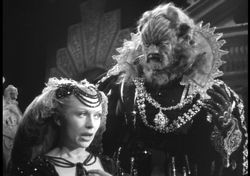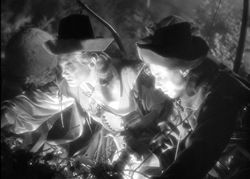
B&W, 1946, 93m. / Directed by Jean Cocteau / Starring Jean Marais, Josette Day / Criterion (US R1 NTSC)
Everyone knows the basic story, but for the record our heroine is Belle (Josette Day), a sweet-natured and dutiful daughter to her father (Marcel André) despite the scorn of her two wicked sisters. With the vain and boorish Avenant (Jean Marais) hovering over her, Belle's prospects seem dim indeed. One day while riding in the woods, her father is caught in a windstorm and takes refuge at a mystical castle where he plucks a single rose to take home to his daughter. Unfortunately the owner, the Beast (Marais again), demands the man's life but offers to take one of his daughters in exchange. Belle is appalled by the thought of sacrificing her father and goes to the Beast's
For the first 15 minutes or so, viewers may wonder what all the fuss is about. Cocteau begins the film in a deliberately flat style, with static compositions flooded with sunlight. However, as with his Orpheus, once we pass through the figurative looking glass into the Beast's palace, the film assumes a life of its own and unspools one remarkable sequence after another. The disembodied arms wielding candles, the Beast's hands smoking after killing a deer, the transformation of Belle's tears into diamonds, and Belle's dreamlike floating through the palace hallways are all images impossible to forget; equally effective is the dreamy Georges Auric score, which wafts through the film like a silvery whisper.
The first film to be issued twice on DVD by the Criterion Collection, Beauty and the Beast made its digital bow in what was considered at the time to be the best the film could possibly look. Though filled with scratches, visible tape splices, and other debris,
Both DVD versions contain an informative audio commentary by film historian Arthur Knight, in which he catalogs Cocteau's influences and innovations while making the film and places it within its correct cinematic context. The reissue adds on a second commentary by writer and cultural historian Sir Christopher Frayling, which focuses more on the fine art and literary aspects of the film and discusses the contributions of everyone involved in a more humanities-related fashion. Both discs contain a text version of the complete original fairy tale by Mme. Leprince de Beaumont and some informative liner notes by Cocteau biographer Francis Steegmuller; after that the supplements part company.
THE ORPHIC TRILOGY:
THE BLOOD OF A POET B&W, 1930, 55m. / Directed by Jean Cocteau / Starring Enrique Rivero, Lee Miller
B&W, 1949, 95m. / Directed by Jean Cocteau / Starring Jean Marais, François Perier
B&W, 1960, 83m. / Directed by Jean Cocteau / Starring Jean Cocteau, Edouard Dermithe, Jean Marais / Criterion (US R1 NTSC)
Criterion designates The Blood of a Poet as the first installment in Cocteau's "Orphic trilogy," a loose interpretation supported mostly by his choice of a young poet as his hero and the fixation with images which would occur in his subsequent films. Cocteau's Orpheus (Orphée), released nineteen years later, is a far more accessible work and is one of his best loved. Derived very loosely from the famous Greek myth, this film begins in contemporary France where the poet Orphée (Cocteau regular Jean Marais) resides with his wife, Eurydice (Marie Déa), in an existence filled with postwar cafes and sleek automobiles. Our hero becomes enchanted with a mysterious and beautiful Princess (Maria Casarès), the personification of Death, who lures him into the underworld through a mirror (what else?). Though Orphée believes himself to be in love with the Princess, he finds his will tested when Eurydice falls prey to the Princess' servants.
Eleven years later, Cocteau took self-reflexive cinema a step further with The Testament of Orpheus (Le testament d'Orphée), the least seen film of the "trilogy." Here Cocteau himself appears as... well, himself, a poet. He wanders through a completely fantastic world populated by his own previous creations (including characters/actors from Orpheus), with Cocteau's close friends and artistic compatriots popping by for surreal cameos. Look fast for appearances by director Roger Vadim, Charles Aznavour, Pablo Picasso, and Yul Brynner, with young future Truffaut star Jean-Pierre Leaud turning up in an homage to Blood of a Poet. More of an internal exploration than a narrative film, Testament has only recently begun to receive acclaim on a level comparable to Cocteau's masterworks thanks to its exposure on cable television and home video.
Criterion's lovingly produced box set treats these films as both a thematic triptych of films and a kind of visual continuum of Cocteau's life and career. The iconoclastic youth of Blood of a Poet makes for fascinating viewing compared to its more refined and contemplative follow up films, which delve more philosophically into the nature of being an artist in a world far different from what one might wish. The transfer quality of the three films is remarkable given the age of these titles; however, the print used for Blood of a Poet, while most likely the best available, has still succumbed to the ravages of time as evident from a number of running scratches and tears which plague the entire running time. However, the other two films look virtually pristine; Orpheus in particular is a revelation compared to the old out of print video editions. The first disc pairs up Blood of a Poet with an informative, carefully designed one hour documentary, Jean Cocteau: Autobiography of an Unknown (Autoportrait d'un inconnu), which covers the artist's seemingly endless capacity for imagination in every artistic field. While the equally sterling South Bank Show episode devoted to Cocteau would have made an ideal companion piece (and shares some of the same footage), this is more than enough for academics and casual viewers alike. As with the other two discs, a number of essays and lecture transcripts reveal both the keen intellect and warm humanity which informed Cocteau's thought processes. The third disc appends a 16mm colour film, Villa Santo Sospir, sort of a dreamy travelogue filmed on the same striking European locations used for Testament of Orpheus.
The greatest fairy tale film ever made, Jean Cocteau's Beauty and the Beast (La Belle et la bête) is both an ideal introduction to the world of foreign cinema and a perfect encapsulation of
 a daydream on film, with enough artistic flourishes to fill a dozen other screen fantasies. Influencing projects as diverse as the Disney animated production of the same and Bram Stoker's Dracula, Cocteau's masterpiece retains its ability to inspire wonder and delight the viewers' senses even after countless viewings.
a daydream on film, with enough artistic flourishes to fill a dozen other screen fantasies. Influencing projects as diverse as the Disney animated production of the same and Bram Stoker's Dracula, Cocteau's masterpiece retains its ability to inspire wonder and delight the viewers' senses even after countless viewings.
 castle, where she becomes a reluctant guest and tries to look past the master's bestial nature.
castle, where she becomes a reluctant guest and tries to look past the master's bestial nature.
 the overall quality was satisfying enough. However, their expanded reissue lays that transfer to waste with an impeccably smooth, wonderfully clean image; you'd have to stare long and hard to find a flaw, amazing for a film once thought to be damaged forever. The audio sounds exceptionally clear and rich, with the music rendered far better than before. The disc also includes a Dolby Digital 5.1 presentation of Philip Glass' opera written for the film, originally performed at live presentations of the film itself. The dialogue is sung in French with Glass' music and stays more or less in sync with the actors throughout. It's a beautifully written work and fares better overall than his hypnotic but disconcerting accompaniment to the 1931 Dracula. Fans of the film will also be delighted to know that, for the first time in an English-speaking home video format, the original and utterly charming opening titles have been restored, with Cocteau drawing the main credits on a blackboard in a classroom full of students.
the overall quality was satisfying enough. However, their expanded reissue lays that transfer to waste with an impeccably smooth, wonderfully clean image; you'd have to stare long and hard to find a flaw, amazing for a film once thought to be damaged forever. The audio sounds exceptionally clear and rich, with the music rendered far better than before. The disc also includes a Dolby Digital 5.1 presentation of Philip Glass' opera written for the film, originally performed at live presentations of the film itself. The dialogue is sung in French with Glass' music and stays more or less in sync with the actors throughout. It's a beautifully written work and fares better overall than his hypnotic but disconcerting accompaniment to the 1931 Dracula. Fans of the film will also be delighted to know that, for the first time in an English-speaking home video format, the original and utterly charming opening titles have been restored, with Cocteau drawing the main credits on a blackboard in a classroom full of students.
 The original (discontinued) disc contains a sole documentary, "Angel of Space and Time," produced for the 1970s cinema appreciation program, Cinematic Eye. Though it's an interesting novelty, the information contained in this film is covered elsewhere in the reissued disc so its loss will be minimal to all but die hard completists. The upgraded DVD adds on a wealth of extras, the most immediately appetizing of which is the film's original French theatrical trailer hosted by Cocteau himself. It's a wonderful promo, with tributes to everyone in front of and behind the camera. A French trailer for the restored edition was also concocted for the theatrical reissue and is included here as well. A 1995 half hour documentary, Projection au Majestic (Screening at the Majestic), returns to several of the original filming locales and features interviews with some of the original principals, including a snowy-bearded Marais and one of the wicked sisters, Mila Parely. A nine-minute interview from 1995 with cinematographer Henri Alekan for French television is also included, while the film's make-up artist, Hagop Arakelian, gets the spotlight in Secrets Professionel: Tete a Tete, a delightful eight-minute, black and white special produced in 1964. Last of all is an extensive still gallery, which features several valuable images documenting the creation of Marais' Beast appearance. An absolutely essential part of any film fantasy or family video library.
The original (discontinued) disc contains a sole documentary, "Angel of Space and Time," produced for the 1970s cinema appreciation program, Cinematic Eye. Though it's an interesting novelty, the information contained in this film is covered elsewhere in the reissued disc so its loss will be minimal to all but die hard completists. The upgraded DVD adds on a wealth of extras, the most immediately appetizing of which is the film's original French theatrical trailer hosted by Cocteau himself. It's a wonderful promo, with tributes to everyone in front of and behind the camera. A French trailer for the restored edition was also concocted for the theatrical reissue and is included here as well. A 1995 half hour documentary, Projection au Majestic (Screening at the Majestic), returns to several of the original filming locales and features interviews with some of the original principals, including a snowy-bearded Marais and one of the wicked sisters, Mila Parely. A nine-minute interview from 1995 with cinematographer Henri Alekan for French television is also included, while the film's make-up artist, Hagop Arakelian, gets the spotlight in Secrets Professionel: Tete a Tete, a delightful eight-minute, black and white special produced in 1964. Last of all is an extensive still gallery, which features several valuable images documenting the creation of Marais' Beast appearance. An absolutely essential part of any film fantasy or family video library.

ORPHEUS
THE TESTAMENT OF ORPHEUS
One of the great voices of the avant garde cinema, Jean Cocteau is that rare director who could make experimental cinema appealing even for the masses. He directed eight feature films and also made a name for himself as a liberal arts renaissance man: painter, writer, visual designer, and actor, among others. Cocteau's first film, The Blood of a Poet (Le sang d'un poète), serves as a kind of Rosetta stone both for the European avant garde and for the controlling images of Cocteau's cinema in general. The dreamlike series of images revolves around a young poet (Enrique Rivero) whose drawings instigate a string of bizarre incidents: a statue comes to life, a mirror leads through to a corridor (a common Cocteau situation), a ritualistic suicide results in reincarnation. The film swerves into "normalcy" when the poet, now transported to a ritzy gambling hall, finds himself subjected to the whims of the social elite, while outside a group of boys have a most unusual snowball fight. Cocteau frames this device with the image of a crumbling chimney, a famous image whose meaning has been the subject of numerous interpretations. Is it a symbol for the inevitability of fate? The potential destruction of the artist's will? A symbol for the images which can flicker through a human mind in the blink of an eye? Cocteau provides no clear answers, and much of the film's enjoyment derives from trying to sort through the fragmented pieces.
